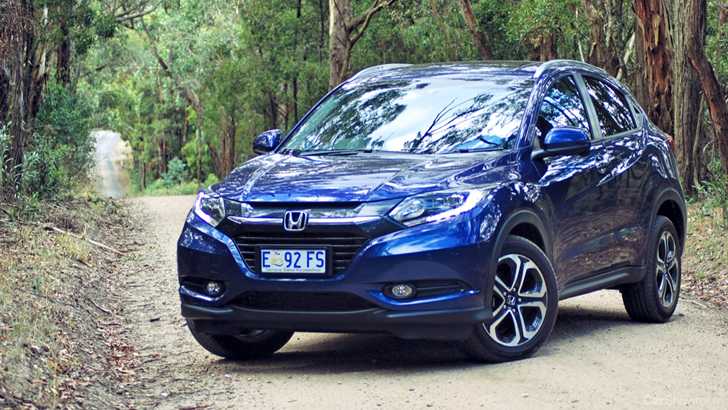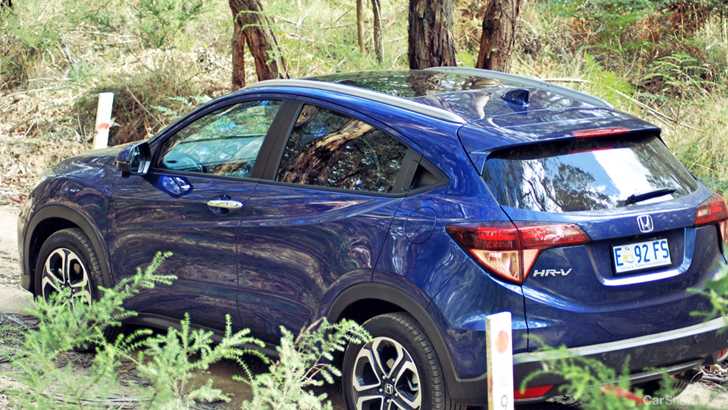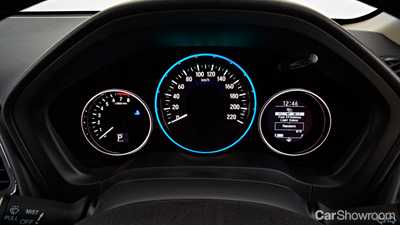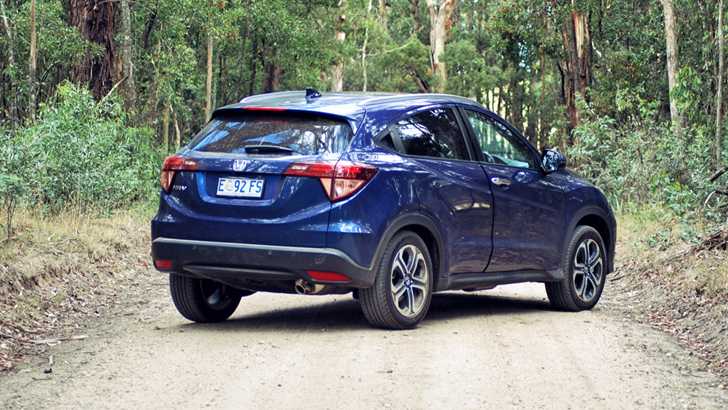In any business getting the timing right pays dividends. So Honda is sitting pretty with its competent all-new HR-V arriving in the compact SUV segment just as sales are lava-hot.
To be frank, getting the timing right hasn’t been a Honda strength for the last six years with the company’s well-publicized battles to overcome the ‘perfect storm’ of Japanese earthquake/tsunami and the floods which wiped-out its plant outside Bangkok in Thailand.
If you think the HR-V nameplate sounds familiar you’d be correct. Honda’s previous HR-V sold here 15 years ago and was very popular. In fact it was somewhat of a ‘game-changer’ back then.
Honda hopes the all-new HR-V will be a ‘game-changer’ in terms of bringing back some much-needed sales volume.
Honda HR-V Overview
Honda is very confident the HR-V will deliver that much-needed boost in sales volumes. So confident that when we called to book a test car they booked two for us – the entry-level VTi ($24,990 or $25,565 as tested with metallic paint) and a range-topping VTi-L ($32,990 or $33,565 as tested with metallic paint).
Two weeks back-to-back in the HRV’s underscored Honda is right to be confident about its all-new compact. In a field full of good cars, the HR-V can go toe-to-toe with any of them on specifications and price.
All Honda HR-Vs currently share the same driveline – the 1.8-litre petrol engine driving the front wheels via a CVT automatic transmission.
Over the Honda HR-V VTi, the range-topping VTi-L adds nice extras like stylish 17-inch alloy wheels, LED headlights, front fog-lights, leather seats, autonomous emergency braking, camera-based ‘Lanewatch’ system, and a panoramic glass roof.
Honda HR-V Engine
HR-V shares the i-VTEC 1.8-litre petrol engine with Honda’s Civic hatchback. As we know this is a surprising single-cam engine which, while revving freely to around 7,000rpm, just isn’t as technologically spectacular as some previous Honda powerplants.
The scourge of optimised fuel consumption and reduced emissions strikes again. We hope some of Honda’s brilliant engine technicians are working away on more exciting/sporty alternatives for future new models.
In the meantime we have the HR-V enjoying 105kW of power at 6,500rpm and peak torque of 172Nm at 4,300rpm.
Drive is to the front wheels via a CVT automatic transmission (the range-topping VTi-L gains paddle shifters).
Combined-cycle fuel consumption ranks at 6.6l/100kms for the VTi model or 6.9l/100kms for the VTi-L.
Honda HR-V The Interior
In the way of modern Honda designs, the HR-V presents a handsome dashboard layout with a large seven-inch touchscreen centre-mounted and driver-focused instruments in a stylishly shaped small binnacle. Unfortunately that good-looking dashboard doesn’t contain a Honda satellite navigation system in any HR-V model.
The seven-inch touchscreen can link with an iPhone and navigation app to provide a jury-rigged system (if there’s a data connection). A most peculiar omission.
As per standard compact SUV practice, the centre console is raised and chunky (to provide SUV-like differentiation from normal hatchbacks). And as per standard Honda practice the driving position is nicely sporty with the small three-spoke steering wheel nicely positioned – although the under-thigh support of the front seats is a bit lacking (a common design twist to provide more space).
Pleasingly all of the cabin materials are nice quality (leather seats and panoramic glass roof for the range-topping VTi-L).
Rear-seat accommodation is impressive - family-friendly for sure and arguably one of the best in this segment.
Of course the Honda HR-V’s major ‘party trick’ is the ‘Magic Seats’ (the rear squabs tumble-fold in unison with the seatbacks folding). So we have 437-litres of cargo space with the rear seat in-place or massive 1024-litres when folded.
Honda HR-V Exterior & Styling
When it comes to curves, character lines, creases and bulges, Honda’s designers didn’t leave much on the shelf when they penned the HR-V. Because that’s the way with these latest-generation compact SUVs – give them plenty of ‘eye-candy’ so they have a more imposing on-road presence than say conventional hatchbacks.
And it’s a curious thing – the Mazda CX-3 looks as you’d expect a Mazda to look and the Honda HR-V looks like you’d expect a Honda to look. It’s a family familiarity thing we guess.
And the CX-3 actually looks nothing like a Mazda2 just like the HR-V looks nothing like a Jazz.
No doubt about it, the Honda HR-V is very pleasing to look at (the snazzy 17-inch alloy wheels on our VTi-L did give it some extra pizzaz). The front-end shows Honda’s new corporate ‘face’ with horizontal bars and the Honda ‘H’ large and prominent in the centre of the grille (some are of course moving to put their badges on the leading edge of the bonnet).
We like the complex front bumper layout and naturally we have the modern intricate headlight designs. Underneath the lower air intakes are surrounded by splitter-like aero extensions and deflectors to direct air around the front wheels.
And there’s the now almost standard chiseled bonnet with prominent side creases flowing onto the front guards.
Side profile sees the curving roofline and two-window side glasshouse plus clever ‘C’-pillars which disguise the rear door handles. Prominent creases run from behind the front wheels upwards to the ‘C’-pillars and give a bolder look to the Honda HR-V’s flanks.
Rear-view is no less impressive with modern high-mounted tail-lights, muscly rear three-quarters, a roof spoiler and lots of curves to exaggerate width.
Honda HR-V On The Road
Honda HR-V rides on the same underpinnings as Honda’s Jazz hatchback – MacPherson strut front suspension and torsion beam rear. The VTi runs on 16-inch wheels and the VTi-L uses much nicer-looking 17-inch alloys.
It’s a slick package and the HR-V combines good grip with nice levels of compliance even on poor roads. Over our high-speed mountain roads test loop, both VTi and VTi-L responded well to steering input and weren’t unfazed by mid-corner bumps.
The 1.8-litre was never intended to be a tyre-shredder (more tuned for optimized fuel consumption of course) but we think the CVT automatic blunts performance. Unlike say Nissan’s CVT which can be quite sporty when pushed, the Honda version is more aligned to fuel consumption and thus our VT-i test car spent much of the time in the mountains looking for lower engine speeds (paddle shifters on VTi-L allow for manual changes).
You get used to the throttle response. But the first time we nailed the VT-i’s accelerator pedal to merge on Melbourne’s Tullamarine Freeway, it did seem to take some time for the 1.8-litre and CVT to get the message that maximum acceleration – rather than minimum l/100kms – was the game in-play.
That said, around town the maneuverability of the Honda HR-V was excellent – without doubt one of the easiest compact SUVs for negotiating the urban jungle. Good all-round visibility, a small 10.6-metre turning circle and standard reversing camera are your HR-V friends in the city.
Honda HR-V Issues
Astonishing in 2015 that there is no factory integrated satellite navigation system for the Honda HR-V.
Honda HR-V Verdict
Like arch-rival Mazda, Honda’s leap into the compact SUV segment couldn’t have come at a better time. There’s some serious selling action going on here as buyers vacate hatchbacks, wagons and larger SUVs, attracted by the smart package size and versatility of the HR-V (and the CX-3 and others).
Honda knew the HR-V just had to be good…and it is. Clever too – and we reckon the practicality of those lauded ‘Magic Seats’ will find popularity with buyers in this league.
Honda’s quality is there for all to see and both the VTi and VTi-L look/feel like you’re getting a lot of car for your coin. A pleasing return to form for the Japanese giant some have opined.
Honda HR-V The Competition
Honda’s HR-V faces a task similar to the McLaren-Honda F1 team in 2015. Excellent opposition has ramped-up the degree of difficulty.
And a good place to start is the all-new Mazda CX-3. Mazda’s hot-selling compact SUV kicks-off at $19,990 for the entry-level Neo and ranges to $37,690 for the fully-equipped Akari grade. Mazda CX-3 boasts to-die-for looks and comes with either a 109kW/192Nm 2.0-litre petrol engine or a 77kW/270Nm diesel. Mazda hasn’t gone the CVT automatic route and the SkyActiv 6-speed six-speed auto combines with SkyActiv technology for the engine and chassis to make the CX-3 a standout in this league.
The Qashqai, a product of Nissan UK, also sells briskly because it’s very good. Priced from $25,850 to $38,390, the Nissan Qashqai offers 2.0-litre petrol or 1.6-litre diesel engines and certainly delivers interior space which leaves some in this segment looking underdone.
Peugeot’s recently up dated 2008 should definitely be on your list. Very easy on the eyes and priced from $21,990 to $31,990, the 2008 oozes French style and class and will surprise with its top-notch driving dynamics.
Renault’s all-new Captur also has considerable appeal. We love the Euro-chic style inside and out and this French baby certainly has a presence on-road. Pricing from $22,990 to $27,990 is sharp and a check of the specs will confirm value-for-money is a Renault Captur strong point.







































